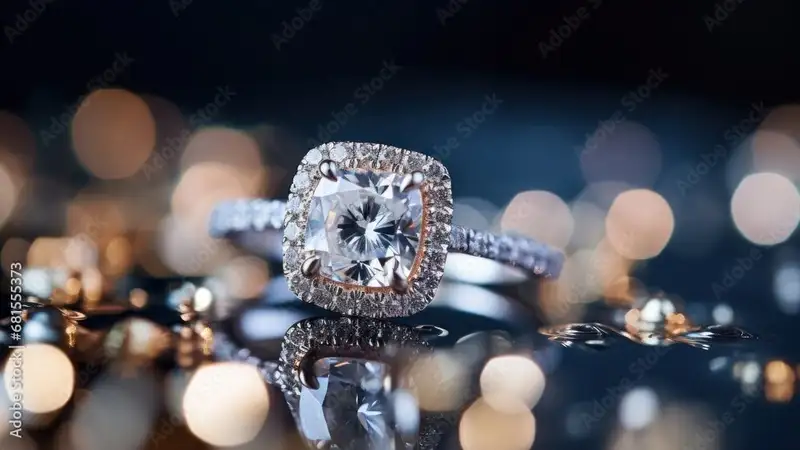Are you curious about the current state of the diamond market in the US and how to navigate it effectively? The US diamond market was valued at approximately $27.1 billion in 2023 and remains a key player globally. It’s influenced by both traditional practices and modern innovations.
With the rise of lab-grown diamonds now constituting 10% of the market and the second-hand market valued at around $5 billion annually, understanding these dynamics is crucial for buyers and sellers alike. Let’s take a closer look.
The Diamond Market in the US
The diamond market in the US remains robust, with a market size valued at approximately $27.1 billion in 2023, driven by a steady demand for engagement rings and luxury jewelry. Major retailers like Tiffany & Co., and Blue Nile dominate the market, while online sales continue to grow, accounting for over 20% of total diamond transactions.
The rise of lab-grown diamonds, which now represent about 10% of the market, is reshaping consumer preferences due to their affordability and ethical appeal. Despite economic fluctuations, the US remains the world’s largest consumer of diamonds, influencing global pricing and trends.
The Second-Hand Diamond Market
The second-hand diamond market in the US is gaining traction, valued at around $5 billion annually, as more consumers seek value and sustainability. This market includes various channels such as online marketplaces, pawn shops, and consignment stores, with platforms like eBay and The RealReal leading in online sales.
Demand is driven by cost savings, with pre-owned diamonds typically selling for 20-40% less than new ones, and environmental considerations, as reselling reduces the need for new mining. This segment also attracts investors, as high-quality diamonds can retain or appreciate in value over time, making it a viable alternative for both buyers and sellers.
What to Know When Buying Diamonds
When buying diamonds, understanding the 4 Cs—Cut, Color, Clarity, and Carat—is crucial, as these factors significantly impact a diamond’s value and appearance. Certification from reputable organizations like the Gemological Institute of America (GIA) is essential for verifying quality and authenticity.
As a consumer you should also be aware that online diamond purchases account for over 20% of total sales, offering a wider selection and competitive pricing. Negotiating prices is common practice, with most retailers marking up diamonds by 20-30%. Buyers should use tools like magnifying loupes to inspect diamonds closely and consider insurance for high-value purchases to protect their investment.
What to Know When Selling Diamonds
When selling diamonds, obtaining an accurate appraisal is crucial, as resale values typically range from 20-60% of the original purchase price, depending on factors such as quality and market demand.
There’s a very common misunderstanding in the diamond trading world about the value of a particular diamond, says one well-known diamond buyer from Phoenix. Most people think their diamond is worth precisely what they purchased it for or what it was “appraised” at another location for, but the truth is most appraisals are going to be different, so keep that in mind.
Trusted methods include private sales, auctions, consignment, and selling directly to retailers, with online platforms like Worthy and Diamond Buyers International offering competitive options. Certification from the GIA or similar organizations can enhance credibility and attract better offers.
Sellers should compare multiple offers and consider timing, as diamond prices can fluctuate based on market conditions. Maintaining detailed records and original receipts can facilitate smoother transactions and potentially higher resale values.
Lab-Grown vs. Natural Diamonds
Lab-grown diamonds, which now constitute approximately 10% of the diamond market, offer a cost-effective alternative to natural diamonds, often priced 30-40% lower. These diamonds are chemically and physically identical to natural ones, but manufacturers create them in controlled environments, eliminating the environmental and ethical concerns associated with mining.
Despite their growing popularity, natural diamonds still dominate the market, valued for their rarity and traditional appeal. However, lab-grown diamonds are gaining acceptance, especially among younger consumers prioritizing sustainability. Both types hold distinct resale values, with natural diamonds typically retaining more value over time due to their inherent scarcity.
Market Insights and Future Trends
Experts expect lab-grown diamonds to capture up to 20% of the market by 2030 due to their affordability and ethical appeal. Consumer preferences are evolving, with a growing emphasis on sustainability and transparency, driving demand for conflict-free and environmentally friendly options. Technological advancements, such as blockchain for supply chain transparency and AI for grading, are set to redefine industry standards.
Economic factors, including fluctuating disposable incomes and global market trends, will continue to influence diamond prices. The rise of e-commerce, projected to account for 25% of diamond sales by 2025, will further transform purchasing behaviors and market dynamics.
Practical Tips and Advice
When buying or selling diamonds, start by thoroughly researching and understanding the 4 Cs—Cut, Color, Clarity, and Carat—to assess value accurately. Always seek certification from reputable bodies like the GIA to ensure authenticity and quality. For buyers, consider online platforms for competitive pricing, as they now account for over 20% of sales.
Sellers should obtain multiple appraisals to gauge fair market value, with resale prices typically ranging from 20-60% of the original purchase price. It’s crucial to maintain detailed records, including original receipts and certificates, to facilitate transactions. You should also ensure proper insurance coverage for high-value diamonds to protect your investment.
Conclusion
We hope you are now ready to navigate the intricate world of diamonds with confidence. Understanding the diamond market’s nuances, from the rising popularity of lab-grown diamonds to the complexities of the second-hand market, equips you with the knowledge to make informed decisions.
With online sales accounting for over 20% of transactions and the second-hand market valued at $5 billion annually, there are numerous opportunities for both buyers and sellers. Always prioritize certification and thorough research, and keep abreast of technological advancements reshaping the industry. By following these guidelines, you can maximize value and ensure ethical practices in your diamond dealings.
